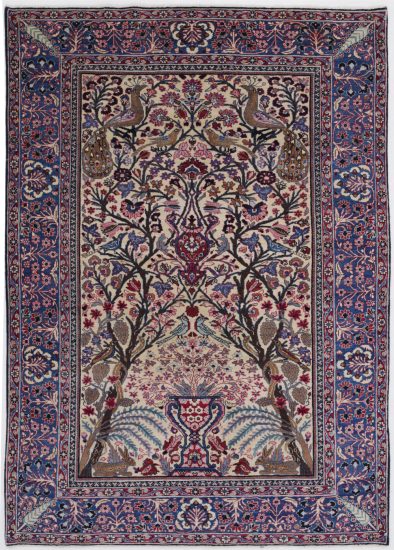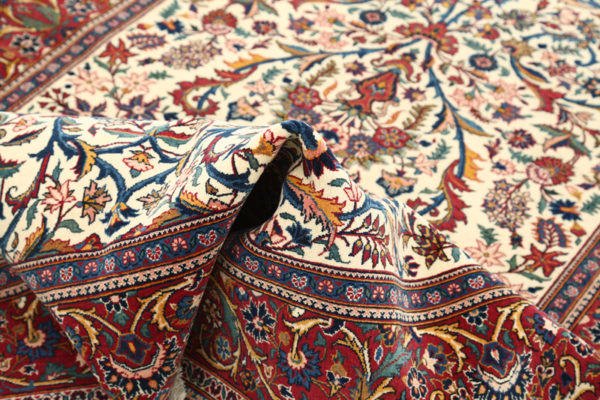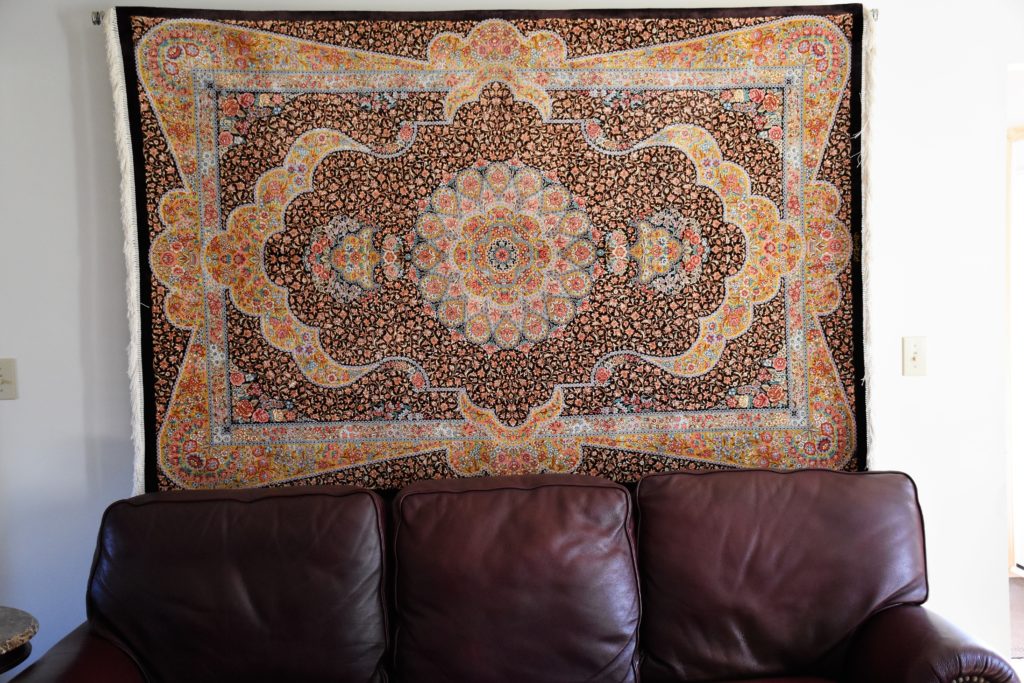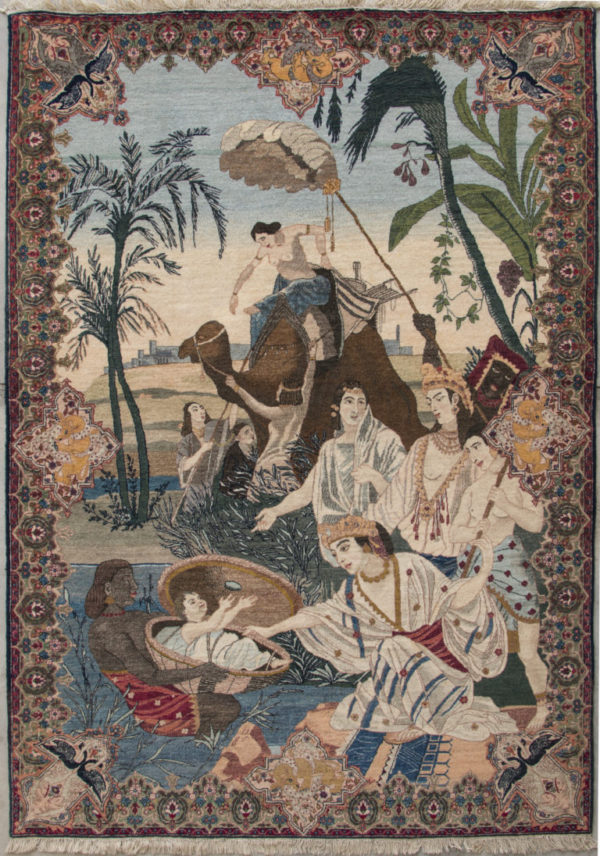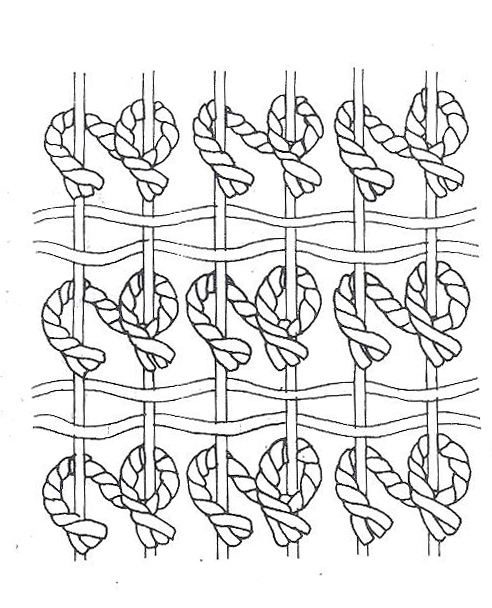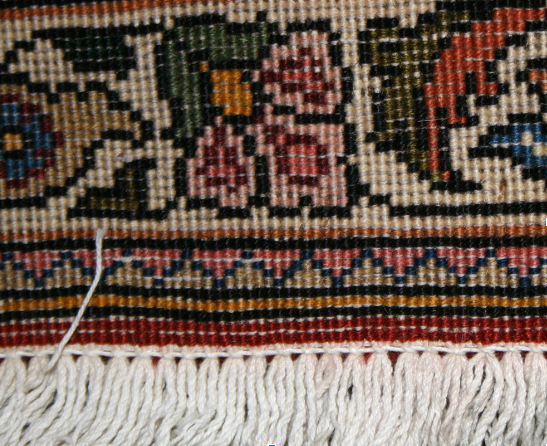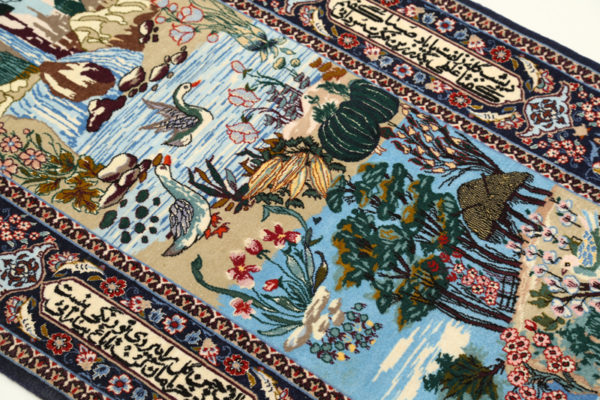Fine Rugs
Fine Persian Rugs
What Makes a Rug a “Fine” Persian Rug?
What exactly do we mean when discussing a “Fine” Persian Rug?
Well, it’s like calling a car a “luxury” car. There are a few standout qualities that take it up a notch.
First, the materials matter. Fine Persian rugs are typically made from high-quality wool, silk, or a blend. The wool is often from high-grade lambs, and the silk is pure and durable. You could say that the materials are the building blocks of the rug’s beauty and longevity.
Second, pay close attention to knot density. This is the number of knots squeezed into a square inch of the rug. A high knot density is a prerequisite for a rug to qualify as a fine Persian rug. The higher this number, the more exquisite the rug.
Next, let’s talk about craftsmanship. Fine Persian rugs are hand-knotted by skilled artisans, which can take months or even years. This painstaking effort results in beautiful rugs, not just functional items but art pieces.
Last but certainly not least are the designs. These genuine Persian rugs feature many traditional patterns and motifs with cultural significance. The patterns are often complex, balanced, and aesthetically pleasing.
Table of Contents
What Affects the Fineness of the Rug
The two main factors affecting a rug’s fineness are the materials used and the weaver’s skill.
High-quality materials such as wool, silk, or cotton, particularly kork wool or silk known for their softness and resilience, contribute to the rug’s fineness.
The texture of these materials, coupled with natural dyes, often results in vibrant and long-lasting colors, enhancing the rug’s overall quality.
The weaver’s skill and experience play a critical role as well. A skilled weaver ties tighter and more consistent knots, enhancing the rug’s durability and the clarity of its design.
Additionally, the time invested in crafting the rug reflects its level of intricacy and finesse — a longer crafting period usually indicates a more detailed and well-executed design.
The perfect combination of high-quality materials and exceptional craftsmanship leads to a stunning collection of fine rugs.
Material
In terms of material, the thicker the yarn used to make the knots, the thicker each knot will be. This results in fewer knots made within a square inch area.
Wool
Wool is a go-to material, and it’s not just any wool but often high-grade lamb’s wool.
The wool varies significantly, both in thickness and knot density. This is because it depends on the source of the wool. Wool obtained from sheep reared by nomadic tribes tends to be thicker and coarser. While they are great for making village rugs, they are unsuitable for fine ones. Fine Persian rugs used high-quality, soft wool from specially reared sheep.
This type of wool is plush, durable, and comes in beautiful natural shades. The fibers can absorb dyes deeply, which means the colors stay vibrant for a long time. It’s the perfect combination of beauty and resilience, so wool is a favorite in rug-making.
Cotton
Cotton is another material commonly found in Fine Persian rugs. Specifically, it’s often used to create the rug’s foundation or the warp and weft.
Cotton is second in terms of the thickness of the fibers and knot density. Cotton provides strength and stability to the rug, allowing it to maintain its shape over time. It’s also less expensive than wool or silk, making rugs with a cotton foundation more affordable while offering high quality.
Silk
Silk is the showstopper material in the world of Fine Persian rugs. Known for its luxurious sheen and softness, silk allows artisans to achieve an incredibly high knot density. Silk can be spun into the finest thread while still retaining its strength.
Weavers working with silk fibers can create the highest number of knots per square inch, leading to incredibly detailed and intricate designs that aren’t impossible with other materials.
Silk Persian rugs are truly the epitome of luxury and fine craftsmanship, making them highly sought after by collectors and rug enthusiasts.
Weaver’s Skill
Although all weavers are highly skilled in the art form of rug weaving, master rug weavers are a class apart. They start learning the art of hand-knotting at a very young age and keep practicing and improving their skills through the years.
Master weaver has developed their skills in weaving rugs to perfection and can create the most intricate and detailed designs by tightly tying the knots to produce some of the finest Persian rugs.
The Difference Between Fine Silk Persian Rugs and Fine Antique Persian Carpets
Silk Persian rugs include rugs that have a 100% silk pile. This silk pile may be constructed on a cotton, wool, or silk foundation. Rugs with a silk pile on a silk foundation are the most valuable.
Fine antique Persian rugs include all at least 100 years old. When categorizing fine antique Persian rugs, the material that the rug is made of doesn’t matter. Only age is factored into this classification.
The Unmatched Excellence of Fine Persian Rugs
Their unparalleled craftsmanship and quality set these high-knot handmade rugs apart. The journey of these rugs begins with the selection of superior, highest-quality materials, such as silk, wool, or cotton, which lend the rugs an incredible suppleness often absent in others.
Fine Persian rugs are known for their exceptional weave and knot count. The high knot count per square inch is a significant feature, bringing forth more defined patterns and allowing the colors to radiate brighter and more vividly. It’s unsurprising that rug enthusiasts highly value these rugs as great investment pieces, while homeowners treasure them as potential family heirlooms.
However, the weaver’s skill and time invested in each piece makes these rugs special. Each knot is meticulously hand-tied by highly skilled weavers. This labor-intensive process can take several months for a small to medium rug and even a few years for larger ones.
You’ll find more than a decorative piece in a Fine Persian rug. You’ll discover traditional rugs embody rich history, dedication, and an unmatched level of craftsmanship, making them so much more than rugs – they are timeless works of art.
How Are Fine Rugs Woven
Fine rugs are woven by master rug weavers who undergo training in the art from a very young age. With years of practice, they gain the higher skill required to pack the knots more tightly and create more detailed designs.
The Senneh knot, an asymmetrical knot, allows the weaver to pack more knots into a square inch. This higher knot density results in cleaner, more defined patterns, increasing the fineness and quality of the rug.
The knots per square inch generally determine what category a rug falls under. A rug with a lower knot count is considered coarse. A rug with a higher knot count is considered a fine-quality Persian rug. The higher the knot count, the higher the quality and the finer the rug.
Knot count indicates the number of knots made within a per inch of the rug, ranging from 25 KPSI to over 1000 KPSI.
How Long Does it Take to Produce a Fine Rug
The time it takes master weavers to produce a fine rug depends on the rug’s size and the knot count. Weavers tie one knot at a time.
Creating more knots per square inch takes a longer amount of time for the same size of rug. On average, a skilled weaver can tie about 10,000 knots a day.
They will have completed a much smaller section with a higher knot count than a weaver working on a coarse rug. Some of the larger fine Persian rugs can take several years to complete. This extended time of Persian rug weaving influenced the price of the rug.
How to Easily Spot a Fine Rug
When it comes to identifying a fine Persian rug, there are several telltale characteristics to look out for:
Intricate Designs and Patterns
The first thing that grabs attention is the level of detail in the designs. You’ll notice complex, precisely drawn patterns requiring high craftsmanship. These designs are often symmetrical, boasting traditional motifs skillfully integrated into the pattern.
Vibrant and Crisp Colors
Fine Persian rugs are known for their vivid hues. The colors are crisp, with depth and richness, that a beautiful rug stands out. Whether they feature bold, contrasting colors or more subtle, harmonious palettes, the color quality is an unmistakable sign of a fine rug.
Sharp Edges
The edges of these rugs are sharp and clean. They showcase the superior workmanship and careful handling that goes into the making of each rug.
Supple Feel
Thanks to high-quality materials and a shorter pile, fine Persian rugs have a soft and flexible texture. This suppleness sets them apart from coarser rugs, making them more comfortable to the touch and adding an element of luxury to any room.
High Knot Count
Lastly, don’t forget to check the back of the rug. A high knot count is a definitive marker of a fine Persian rug. This detail is easily noticeable when you flip the rug over – the knots are dense and meticulously crafted, reflecting the time and effort spent creating these pieces.
In summary, identifying a fine Persian rug involves appreciating the harmony of its designs, the vibrancy of its colors, and the quality of its craftsmanship. Spotting these extraordinary pieces becomes much easier once you know what to look for.
Design Features that Define Fine Persian and Oriental Rug
When it comes to the designs of fine Persian and Oriental rugs, expect a world of enchanting patterns and intricate motifs that tell a captivating story.
Let’s explore some of the key elements you’ll come across:
Floral Motifs
Fine Persian rugs are known for their detailed floral designs. Expect to see elegant blossoms, leafy vines, and verdant trees woven into the fabric of these rugs. These patterns are often symmetrical, creating a harmonious balance and pleasing the eye.
Geometric Patterns
Many fine Persian and Oriental rugs feature geometric designs. These geometric figures can range from repeating patterns of diamonds, triangles, and squares to more complex shapes. You’ll also encounter rugs featuring the famous ‘Herati’ pattern, a stylized floral motif enclosed within a diamond.
Animal Motifs
Some rugs may incorporate animal figures as part of their design. Birds, horses, camels, and lions can often be seen in the decorative scenery. These animals often carry symbolic meaning within the cultural context of the rug’s origin.
Medallion Layouts
One of the most prevalent designs in fine Persian rugs is the medallion layout, where a large central medallion is the focal point of the rug, surrounded by a field of intricate designs.
Border Designs
The borders of fine Persian and Oriental rugs are typically adorned with elaborate patterns that frame the central design. It’s common to see multiple borders, each with a unique design, adding to the rug’s complexity and visual appeal.
Typical Sizes of Fine Persian Rugs and How They Fit into Your Home Styling
When styling your home with high-quality carpets like fine Persian rugs, you’ll find various sizes to suit any interior design style.
Smaller-size rugs, about 2′ × 3′, are perfect for adding a touch of luxury to compact spaces, under a coffee table, or by your bedside.
Medium-size rugs ranging from 3′ × 5′ to 5′ × 7′ can provide a cozy, rich aesthetic to study rooms or under a small dining table.
Large rugs, varying from 5′ x 8′ to 9′ × 11′, make great centerpieces in spacious living rooms or under a large dining set.
Oversized fine Persian rugs are also available, perfect for transforming an expansive room into a grand and welcoming space.
Remember, the right rug size can make a huge difference in bringing together your home’s design elements.
